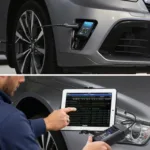An OBD2 code reader, also known as a scan tool, is an essential tool for any car owner. Understanding how to use an OBD2 code reader can empower you to diagnose car problems, potentially saving you time and money on costly mechanic visits. This guide will provide a comprehensive walkthrough on how to effectively use an OBD2 code reader.
Using an OBD2 code reader isn’t rocket science. Locating the OBD2 port is usually the first step. It’s typically found under the dashboard on the driver’s side, though its location can vary slightly depending on the car model. Once located, simply plug the OBD2 code reader into the port. Then, turn on the ignition, but don’t start the engine. This powers up the code reader and allows it to communicate with your car’s computer. how to use obd2 reader to check codes provides a more detailed explanation of this process.
Understanding Diagnostic Trouble Codes (DTCs)
Once the OBD2 code reader is connected and powered up, it will begin to read diagnostic trouble codes (DTCs) from your car’s computer. These codes are standardized and consist of a five-character alphanumeric sequence. Each code corresponds to a specific issue within your car’s systems. For instance, the code P0300 refers to a random misfire detected. Understanding these codes is key to properly diagnosing your car’s problem.
Decoding the Codes
Breaking down the structure of DTCs can be incredibly helpful. The first character, a letter, indicates the system the code refers to. “P” signifies powertrain, “B” is for body, “C” is for chassis, and “U” is for network communication. The second character represents whether the code is generic (0) or manufacturer-specific (1). The third character indicates the specific subsystem, such as the fuel system or ignition system. The last two digits pinpoint the exact fault within that subsystem.
Troubleshooting with an OBD2 Code Reader
An OBD2 code reader is more than just a code retriever. It can also be used for troubleshooting. By monitoring live data streams, such as engine speed, coolant temperature, and oxygen sensor readings, you can gain valuable insights into your car’s performance. This allows you to identify potential issues and narrow down the possible causes of a problem. how to use zurich obd2 code reader zr8 provides a practical example of this functionality with a specific code reader model.
Using Live Data Streams
Navigating through the live data streams on your OBD2 code reader might seem daunting at first, but with a little practice, it becomes second nature. Select the desired parameter you want to monitor, and the code reader will display its real-time value. Observing how these values change under different driving conditions can help you pinpoint issues that might not trigger a DTC. You can find specific instructions on how to use the obd2 code reader.
“Understanding how to use live data is crucial for advanced diagnostics. It allows you to see the intricate workings of your vehicle in real time, providing a depth of understanding that simply reading codes can’t offer.” – John Davis, Automotive Diagnostic Specialist
Clearing Codes
After repairing a problem, you can use the OBD2 code reader to clear the DTCs from your car’s computer. This is essential to ensure that the “check engine” light turns off and that the car’s computer can accurately monitor for new issues. However, simply clearing codes without fixing the underlying problem is not a solution. how to use obd2 code reader bafx offers a guide to clearing codes on a specific device.
“Remember, an OBD2 code reader is a diagnostic tool, not a magic wand. It helps pinpoint issues, but proper repair still requires mechanical knowledge and expertise.” – Maria Sanchez, Certified Mechanic
Conclusion
Learning how to use an OBD2 code reader is a valuable skill for any car owner. From diagnosing trouble codes to monitoring live data and clearing codes, an OBD2 code reader empowers you to take control of your car’s maintenance and avoid unnecessary expenses. how to use craftsman obd2 code reader provides further examples for different code reader models.
FAQ
- What does OBD2 stand for? On-Board Diagnostics, generation 2.
- Where is the OBD2 port located? Usually under the dashboard on the driver’s side.
- Can I use any OBD2 code reader on any car? Most OBD2 code readers are compatible with cars made after 1996 in the US.
- What should I do if the code reader doesn’t power on? Check the car’s ignition and ensure it’s in the “on” position without starting the engine.
- What do I do after reading a code? Research the code online or consult a repair manual to understand the issue and determine the necessary repairs.
- Is it safe to clear codes? Yes, but it’s crucial to address the underlying problem causing the code.
- How often should I use an OBD2 code reader? Periodically, or whenever you suspect a problem with your vehicle.
Common OBD2 Code Reader Scenarios
- Check Engine Light Illuminates: This is the most common trigger for using an OBD2 code reader.
- Performance Issues: If your car is experiencing problems like rough idling, misfiring, or reduced fuel efficiency, an OBD2 code reader can help identify the cause.
- Preventative Maintenance: Regularly scanning your car can help identify potential problems before they become major issues.
Further Resources
Explore our website for more helpful articles on using OBD2 code readers: How to use a specific brand or model, in-depth troubleshooting guides, and more.
For support, contact us via WhatsApp: +1(641)206-8880, Email: [email protected] or visit our office at 789 Elm Street, San Francisco, CA 94102, USA. We offer 24/7 customer support.


